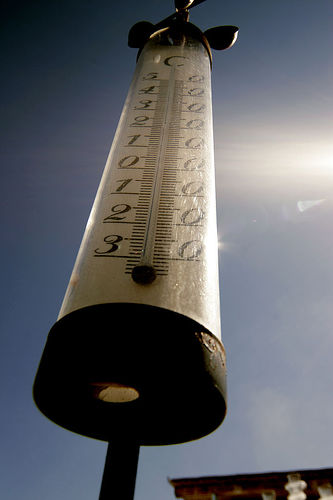From 2009 to 2014, projected rises in anthropogenic influences and solar irradiance will increase global surface temperature 0.15 ±0.03 °C, at a rate 50% greater than predicted by IPCC.
So conclude Judith Lean, of the US Naval Research Laboratory, and David Rind, of NASA’s Goddard Institute for Space Studies in a new Geophysical Research Letters study, “How Will Earth’s Surface Temperature Change in Future Decades?” (subs. req’d). The UK Guardian explains:
The work is the first to assess the combined impact on global temperature of four factors: human influences such as CO2 and aerosol emissions; heating from the sun; volcanic activity and the El Niño southern oscillation, the phenomenon by which the Pacific Ocean flips between warmer and cooler states every few years.
This study does not assume we will have a major El Niño, but notes that if we did have a really big one, it could add as much as 0.2°C [0.36°F] to the temperature in an individual year. In the July 27 weekly update by NOAA’s National Centers for Environmental Prediction, “ENSO Cycle: Recent Evolution, Current Status and Predictions,” NCEP notes “Current observations and dynamical model forecasts indicate El Niño conditions will continue to intensify and are expected to last through” the winter, and “nearly all of the dynamical models predict a moderate-to-strong episode.” So again, it looks NASA’s January prediction is accurate,
Given our expectation of the next El Niño beginning in 2009 or 2010, it still seems likely that a new global temperature record will be set within the next 1-2 years,
Significantly, a 2007 Hadley Center paper in Science: “Improved Surface Temperature Prediction for the Coming Decade from a Global Climate Model” (see “Climate Forecast: Hot – and then Very Hot“) also concluded:
Our system predicts that internal variability will partially offset the anthropogenic global warming signal for the next few years. However, climate will continue to warm, with at least half of the years after 2009 predicted to exceed the warmest year currently on record.
That 2007 paper predicted roughly twice as much warming by 2014 as the new study.
A 2008 Nature paper that confused many actually found that the coming decade is poised to see faster temperature rise than any decade since the authors’ calculations began in 1960 (see “Nature article on ‘cooling’ confuses media, deniers: Next decade may see rapid warming“).
The new GRL paper seems highly credible:
By representing monthly mean surface temperatures in terms of their combined linear responses to ENSO, volcanic and solar activity and anthropogenic influences, we account for 76% of the variance observed since 1980 (and since 1889, Lean and Rind, 2008) and forecast global and regional temperatures in the next two decade.
The authors note that:
… our empirical model predicts that global surface temperatures will increase at an average rate of 0.17 ±0.03 °C per decade in the next two decades….
Northern mid latitudes, especially western Europe, will experience the largest warming (of as much as 1°C)….
Of course, Americans also live in the Northern mid latitudes.
Notwithstanding the occasional confused study, we continue, sadly, to be on track for every decade this century being the hottest decade in recorded history.”


